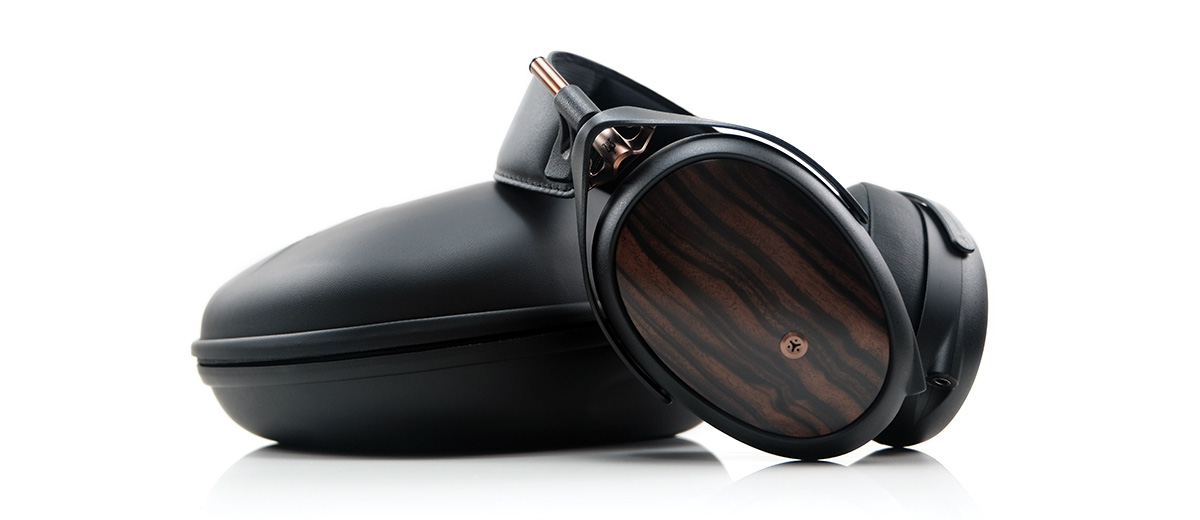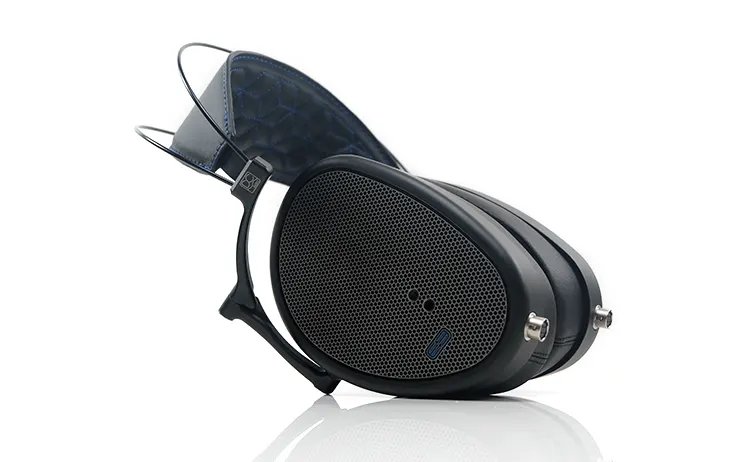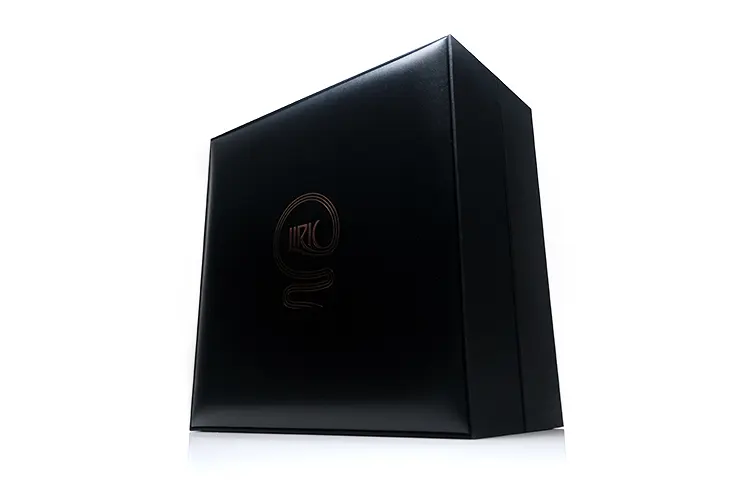Selected Comparisons
The following comparisons to the Meze Audio Liric II were completed using a mix of the Cayin N7 1BIT DAC and pre-out connected to the Ferrum OOR/HYPSOS as the main source and amplification.
Meze Audio Liric
The original Liric was launched at the end of 2021 with our review in early 2022. The Liric also won our 2022 Top Gear Best Closed-Back Headphones award for that same year.
Technical
We have gone through most of the major changes in some detail on page 1 so more of a light touch here.
Both models share the same Rinaro Isodynamic Hybrid Array MZ4 driver originally developed for the Liric line and both include Phase-X imaging technology and PES airflow management specific to Meze’s work on enhancing closed-back acoustical and driver performance.
The key difference in the new QWRM technology and secondary to that, the change to a detachable pad system.
QWRM is a quarter wavelength resonator mask and you can see it on the driver frame on the inside when you take off the earpad. It is designed to help Meze refine the post-7k or treble tuning of the Liric II to something a bit lower and more refined than the original.
The new detachable pad system might not immediately seem like it will change the tuning since the pads are the same as the original. However, it does give Meze the ability to craft different pads for you to buy that could change the tuning much like the Empyrean II or Elite pads.
The Liric II is rated at 61Ω. That is double the load of the original which was rated at 30Ω but the nominal SPL is unchanged at 100 dB/mw.
Design
Lots of matching features between these two but with only one huge difference and a couple of changes that I would classify as more subtle.
The biggest difference is in the Liric II’s aesthetic with that flash of Macassar ebony on the cup plates. The original was a matte black finish that blended in with the matching magnesium alloy frame whereas this one stands out a bit more.
I suspect there will be opinions on both so whilst not a clear-cut objective improvement, subjectively it might swing some woody lovers over to the new finish with its more unique look.
The more subtle change is in the weight with an additional 30+ grams on the Liric II from the additional magnet system inside the cups for the new pads and a small QWRM plate on the frame.
We have covered the new detachable pads already in some detail. I think it’s a huge plus and gives Meze a lot of options for tweaking further down the line.
The last is the Liric II cable line-up. The switch to the Furukawa PCUHD copper cable and going balanced 4.4mm with the shorter cable is a good move.
This is a better quality wire than the older version’s thin black rubbery designs and its performance both in handling and lowering levels of resistance is much improved. It also looks much better in its finishing compared to the older cables.
Performance
On a general level, the Liric II is more U-shaped than the original with additional emphasis on the lows and upper treble but not as peaky or as edgy-sounding as the original on the highs. The ‘U’ is more about reducing the midrange forwardness than massively boosting either end of the Liric II’s frequency response.
Having said that, the bass shelf of the Liric II is fuller and warmer sounding with less of a cut into the lower mids compared to the original. The Liric remains the punchier of the two headphones but it is not as weighty as the Liric II’s set of lows when called upon.
The reduction in mid-forwardness combined with some additional warmth from the lows gives the Liric II’s mids a more relaxed and smoother sound signature. Especially around 1-2k, you get some additional timbral sweetness with a light sheen from the treble.
At times it sounds more immersive or complete in its presentation. I mentioned ‘at times’ because I find that going more U-shaped in headphone tuning tends to bring with it some pros and cons.
For example, Liric II’s vocal imaging from lounge artists such as Laufey does much better in blending the supporting band around her stage position rather than the original which shoved instruments halfway down the corridor.
The resulting Liric II mix sounds coherent and immersive rather than fatiguing and disjointed hence it becomes a much more enjoyable listening experience.
On the other hand, energetic EDM mixes that favor bass and treble will dominate light-bodied female vocals on the Liric II making them slightly harder to connect with.
If vocal impact alongside bassy EDM is important to you I would compare both and see how you feel about the change in midrange presence between the two headphones.
Dan Clark Audio E3
The Dan Clark Audio E3 was launched at the end of 2023 with our review coming out at the start of this year. Its price point is the same as the Liric II making it one of its main competitors.
Technical
Both are planar driver designs but very different approaches save for possibly their respective AMTS, (E3) and QWRM, (Liric II) which do have some overlapping tuning intent.
The E3 uses a 5th generation single-sided V-planar driver measuring in at 72x45mm whereas the Liric II’s driver is a little bit bigger at 92 mm x 63 mm though DCA does not declare the size of the active area of their driver.
The centerpiece is the E3’s AMTS technology which stands for Acoustical Metamaterial Tuning System. It’s a honeycombed wedge that sits on top of the driver with programmable waveguides engineered to manipulate the sound waveguides and diffusion control from the driver.
It will act much like the Liric II’s QWRM technology as it doubles up as a programmable Helmholtz or quarter-wave resonator for high-frequency standing waves and resonance.
The E3 has a lower load but it is not as efficient as the Liric II’s MZ4 driver at 27Ω impedance and -90 dB/mW sensitivity compared to 61Ω and 100 dB/mW. You will find that the E3 is more demanding and it does prefer higher output portable or desktop gear compared to the Liric II.
Design
In my opinion, the E3 and the Liric II are the two most comfortable closed-back headphones on the market today.
They have very different approaches to how they get there but having tried more than a few closed-back full-sized headphones I always come back to these two for longer-listening sessions and a degree of portability.
At 455g the E3 is only marginally heavier than the Liric II’s 427g weight but they feel quite different on the head due to how each company has approached the pressure dissipation.
The E3 frame is so low-profile with its Nitinol headband and pressure strap. The large cups and half-gimbal structure dominate the form factor, much more so than the Liric II’s smaller cups and pad openings.
As a result, the dominant pressure on the E3 is more lateral than vertical so you tend to feel those cups on the side of your head more than the Liric II which has more of a balanced dissipation between vertical and lateral.
The downside of the Liric II pads is the smaller opening with less ‘ear clearance’ compared to the E3. You feel more pressure on your ear whereas the E3 clears the ear putting it more on the side of your head.
Aesthetically, I find it hard to separate either as they move in very different directions. Both have topical and interesting plate applications with the Gorilla Glass on the E3 and the ebony finish on the Liric II.
The one killer feature I do wish the Liric II had was that folding mechanism from the E3. That gives the E3 a big advantage in terms of how compact it can get with its matching carry case when compared to the Liric II case dimensions.
Performance
The DCA E3 is a ‘bigger sounding’ or airier headphone with the Liric II offering the more intimate staging quality of the two headphones.
The E3 does better fleshing out the lower treble adding a bit more energy to higher pitching notes that give it a more balanced sound signature but also adds a stronger perception of height to the presentation.
Where the Liric II might pull ahead for some is the mid-bass bloom and added upper bass and lower mids warmth. It provides a fuller and warmer tone through the mids with a less fatiguing richer tonal quality to both instrument and vocal that is more suitable for some modern synth and pop music.
Arguably, the E3 is the more tonally correct-sounding headphone. It has a mid-bass nudge that provides some solid impact but there is less bloom through the mid-bass and more sub-bass presence that creates some much-needed space and staging depth for the mids of the E3 to shine.
The lack of bloom does mean notes from the E3 are a little lighter and not as dense or as rich sounding as the Liric II. However, they also seem easier to pick out in general listening giving you a stronger perception of articulation and detail.
Overall, the E3 has a cleaner more spacious sound, and potentially the more resolving of the two headphones with more sub-bass presence. The Liric II is a smoother, more intimate, and denser-sounding tuning. Also, it may well be the less fatiguing of the two for vocals in certain genres.
Audeze LCD-XC 2021
As the name suggests, the Audeze LCD-XC got a refresh in 2021 with our review coming out in August of that year. As of writing today, it is still Audeze’s flagship closed-back headphones and part of their wider Reference Series.
Technical
Again, like the E3, Audeze brings a raft of different ideas for the implementation of their planar driver inside the LCD-XC 2021.
Of the compared headphones including the Liric II, the LCD-XC 2021 has the largest driver with a 106mm diameter Ultra-Thin Uniforce planar diaphragm and a dual-sided Neodymium N50 magnet stacked array.
Each headphone brings its in-house technology for venting and optimizing the driver. The Liric II uses Phase-X, PES, and its new QWRM resonator mask technology to optimize imaging, and spaciousness, allowing the driver to vent properly, and tone down the 7kHz upwards region.
The LCD-XC 2021 uses Audeze’s long-standing Fazor waveguide technology, (6 windows) that reduce soundwave flow resistance, reducing interference and diffraction. It also does ‘PES’ a bit differently with earpad rings that are subtly lifted to introduce some enhanced venting alongside a more porous memory foam inside the pads.
At 20Ω impedance, the LCD-XC 2021 has a lower load than the Liric II’s 60Ω equivalent on a 32Ω load. However, the LCD-XC 2021 is marginally more sensitive at 101 dB/mW compared to 100 dB/mW on paper.
However, in our real-world testing on the Ferrum OOR’s balanced high gain output, the LCD-XC 2021 sounded a lot easier to drive.
Design
The LCD-XC 2021 comes close to the passive isolation capability of the Liric II but you have to put 677g of weight on top of your head to get there.
As much as I love the comfort of those LCD-XC 2021 leather pads and just how big that inner cavity is for clearing your ears, there is no mistaking the vertical pressure pull of a headphone that is 50% heavier than the Liric II.
That is not to say the LCD-XC 2021 is not well built because it is. It’s robust, well-balanced, and not overly strong on the clamp. If you can get past the weight it’s quite comfortable on the ear with plenty of articulation for various head sizes. Rather, it’s not built for easy portability which the Liric II is.
There is an unmistakable Audeze design language running through it from the LCD series though in some ways the MM Series and the LCD-5 are now the more modern and lighter Audeze design approach.
I think Meze has a more elegant approach to design, not just the Liric II but their higher-end models. Audeze’s weight loss in their later models does show though that they can adapt with the LCD-5 looking particularly cool, albeit still with a challenging comfort issue.
Also, I do wish Audeze would produce easily detachable pads. Yes, you can change them with those adhesive backs and I have done 1-2 of them but the detachability of the Liric II pads is much easier and more flexible for the everyday user.
Performance
The tuning on the LCD-XC 2021 sounds like what would happen if you turned the Liric II’s tuning upside down, metaphorically speaking.
The Audeze is very much a mid-forward sound signature with vocal imaging well ahead of a flatter more neutral bass tuning. The Liric II’s bass is more elevated giving it more perceived depth and weight but also additional warmth into a much more relaxed midrange tonal quality.
Such is the difference in imaging and change in timbre through the mids between these two you could be forgiven for thinking you are listening to different vocalists.
The LCD-XC 2021 harmonic balance always shifts your ear upwards with a lighter even-harmonic presence and a more dominant upper-harmonic influence on vocal coloration.
However, a lower level of treble elevation means the vocal notes are not too lean or sibilant with a strong forward focus, somewhat similar to the older Liric’s elevation from 1-3k but not as edgy.
Can they be more fatiguing when compared to the richer, smoother, and most relaxed Liric II presentation? Most certainly if the recording is quite bright, but they also have their charm for slower softer recordings.
One thing to note is that heavy energy on the lows can diminish the presence of some vocal registers on the Liric II. That is not the case with the LCD-XC 2021. It will not offer the same weighty note fundamental but its refined and tighter delivery is more reference-like than the Liric II’s denser warmer overtone.
I would pick the Liric II for modern rock and pop, the better fundamental and cleaner highs give it more drive and sparkle. The LCD-XC 2021’s more refined vocal delivery and wider stereo imaging make it a better contender for mid-centric music.
Our Verdict
The Meze Audio Liric II is a good improvement over the original with a smoother, more coherent, and relaxed sound signature making it a more competitive closed-back planar headphone for a wider range of musical genres.
It pairs impressively with portable sources right down to a few quality dongle choices giving it a welcome portable dimension. However, the Liric II sounds optimal with the additional power from desktop setups, particularly solid-state amps with a clean or energetic sound signature.
My only caveat is how competitive the closed-back planar headphone space has become in the last 1-2 years. The likes of the Dan Clark Audio E3 I reviewed earlier this year will provide a worthy alternative, particularly in its stellar staging properties.
For the audiophile, that’s a good thing, because the Liric II has a very different identity and one that should appeal to those who want a rich yet articulate sound from a very well-built and supremely comfortable set of closed-back headphones.
Meze Audio Liric II Technical Specifications
- Driver Type Rinaro Isodynamic Hybrid Array® MZ4
- Size 92 mm x 63 mm
- Active Area 3.507 mm2
- Driver Weight 71g
- Casing Fibreglass reinforced polymer
- Impedance 61Ω
- Sensitivity 100 dB (1 mW / 1 kHz)
- Frequency Range 4 Hz – 92,000 Hz
- Maximum SPL > 130 dB
- Diaphragm Weight 0.08g
- Total Harmonic Distortion (THD) < 0,15%
- Acoustic Mass 6.5 kg/m4
- Weight 427g





